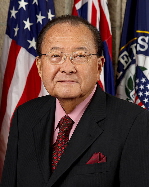Which States Have the Longest-Serving US Senate Delegations?
Hawaii and Iowa lead the pack with battleground states littering the Bottom 10; Daniel Inouye’s 48+ years of service is equal to 33 other Senators combined

The new 112th Congress now finds more than 40 percent of its members in the upper legislative chamber have not yet served one full term.
The 2012 election is still more than a year and a half away, but five members in their third full term or greater have already announced their retirement (Democrats Jeff Bingaman of New Mexico and Kent Conrad of North Dakota; Independent Joe Lieberman of Connecticut; Republicans Jon Kyl of Arizona and Kay Bailey Hutchison of Texas) along with first term Democrat Jim Webb of Virginia.
That means it is quite likely the 113th Congress that convenes in 2013 will find an even greater percentage of Senators who have yet to complete a full term than in the 112th – should at least five more senators announce their retirement or get defeated in their reelection bids.
Despite the member upheaval that the Senate has experienced over the past few election cycles, there are certainly still several state delegations with a wealth of experience in the nation’s upper legislative chamber.
Senators from Hawaii (68.2 years) and Iowa (56.2 years) are far and away the most seasoned in the 100-member body.

In fact, Inouye’s length of service is equal to the combined service of 33 individual members of the Senate: the delegations from Colorado, Minnesota, Missouri, New Hampshire, Ohio, Pennsylvania, and Virginia, plus the junior senators from Alaska, Arkansas, Connecticut, Delaware, Florida, Idaho, Illinois, Kansas, Kentucky, Massachusetts, Nebraska, New Mexico, New York, North Carolina, North Dakota, Oregon, Utah, West Virginia, and Wisconsin.
Rounding out the Top 10 for the state delegations with the most years of service in the Senate are Indiana at #3 (44.2 years), Michigan at #4 (42.2 years), Arizona and Vermont at #5 (40.2 years), Alabama at #7 (38.2 years), California at #8 (36.4 years), Montana at #9 (36.3 years), and Mississippi at #10 (35.3 years).
Indiana maintained its Top 10 ranking on the list from a year ago despite the retirement of two-term Democrat Evan Bayh thanks to the return of Republican Dan Coats, who won back his old seat that he previously held for 10 years from 1989-1998.
(Note: Coat’s experience does not carry over for seniority purposes, except as a tie-breaker among his current class, so Indiana ranks only 18th in average seniority ranking among the 50 states).
Five states fell out of the Top 10 from a year ago due to retirements, death, or unsuccessful incumbent reelection bids: West Virginia (from #1 to #19), Utah (#4 to #11), Connecticut (#4 to #24), North Dakota (#7 to #22), and Wisconsin (#9 to #24).
It should come as little surprise that almost all of the Bottom 10 states on this list are among the premier battleground states in the nation.
The state delegations with the shortest cumulative service are New Hampshire (#50, 2.2 years collectively), Colorado, Missouri, Ohio, and Pennsylvania (#46, 4.2 years), Minnesota (#45, 5.7 years), Virginia (#44, 6.2 years), North Carolina and Arkansas (#42, 8.2 years) and Florida (#41, 10.2 years).
Retirements have caused some of these seats to open up over the past year, such as Judd Gregg in New Hampshire, George Voinovich in Ohio, and Kit Bond in Missouri.
However, 14 of the 20 seats across these Bottom 10 states saw a flip in partisan control when won by the current sitting member: both seats in North Carolina (2004, 2008), Virginia (2006, 2008), Pennsylvania (2006, 2010), and Arkansas (2000, 2010), and seats in Minnesota (2008), Colorado (2008), Missouri (2006), Ohio (2006), New Hampshire (2008), and Florida (2000).
Length of Service in the U.S. Senate by State Delegation
|
2011 Rank
|
2010 Rank
|
State
|
Senior
|
Junior
|
Total
|
|
1
|
2
|
Hawaii
|
48.1
|
20.8
|
68.9
|
|
2
|
3
|
Iowa
|
30.1
|
26.1
|
56.2
|
|
3
|
6
|
Indiana
|
34.1
|
10.1
|
44.2
|
|
4
|
8
|
Michigan
|
32.1
|
10.1
|
42.2
|
|
5
|
9
|
Arizona
|
24.1
|
16.1
|
40.2
|
|
5
|
9
|
Vermont
|
36.1
|
4.1
|
40.2
|
|
7
|
12
|
Alabama
|
24.1
|
14.1
|
38.2
|
|
8
|
14
|
California
|
18.3
|
18.1
|
36.4
|
|
9
|
15
|
Montana
|
32.2
|
4.1
|
36.3
|
|
10
|
16
|
Mississippi
|
32.2
|
3.1
|
35.3
|
|
11
|
17
|
Nevada
|
24.1
|
10.1
|
34.2
|
|
11
|
4
|
Utah
|
34.1
|
0.1
|
34.2
|
|
13
|
19
|
New Jersey
|
26.1
|
5.1
|
31.2
|
|
14
|
20
|
Maine
|
16.1
|
14.1
|
30.2
|
|
14
|
20
|
New Mexico
|
28.1
|
2.1
|
30.2
|
|
16
|
23
|
Maryland
|
24.1
|
4.1
|
28.2
|
|
16
|
23
|
Washington
|
18.1
|
10.1
|
28.2
|
|
18
|
26
|
Massachusetts
|
26.1
|
1.0
|
27.1
|
|
19
|
1
|
West Virginia
|
26.1
|
0.2
|
26.3
|
|
20
|
12
|
Kentucky
|
26.1
|
0.1
|
26.2
|
|
21
|
27
|
Texas
|
17.7
|
8.1
|
25.8
|
|
22
|
7
|
North Dakota
|
24.1
|
0.1
|
24.2
|
|
23
|
28
|
Oklahoma
|
16.3
|
6.1
|
22.4
|
|
24
|
4
|
Connecticut
|
22.1
|
0.1
|
22.2
|
|
24
|
9
|
Wisconsin
|
22.1
|
0.1
|
22.2
|
|
26
|
29
|
Louisiana
|
14.1
|
6.1
|
20.2
|
|
26
|
29
|
South Dakota
|
14.1
|
6.1
|
20.2
|
|
28
|
33
|
Rhode Island
|
14.1
|
4.1
|
18.2
|
|
29
|
34
|
Wyoming
|
14.1
|
3.7
|
17.8
|
|
30
|
35
|
Oregon
|
15.0
|
2.1
|
17.1
|
|
31
|
36
|
Illinois
|
14.1
|
0.2
|
14.3
|
|
32
|
38
|
Georgia
|
8.1
|
6.1
|
14.2
|
|
32
|
38
|
Idaho
|
12.1
|
2.1
|
14.2
|
|
32
|
22
|
Kansas
|
14.1
|
0.1
|
14.2
|
|
32
|
38
|
New York
|
12.1
|
2.1
|
14.2
|
|
32
|
38
|
South Carolina
|
8.1
|
6.1
|
14.2
|
|
37
|
42
|
Nebraska
|
10.1
|
2.1
|
12.2
|
|
38
|
42
|
Tennessee
|
8.1
|
4.1
|
12.2
|
|
39
|
42
|
Delaware
|
10.1
|
0.3
|
10.4
|
|
40
|
46
|
Alaska
|
8.2
|
2.1
|
10.3
|
|
41
|
45
|
Florida
|
10.1
|
0.1
|
10.2
|
|
42
|
29
|
Arkansas
|
8.1
|
0.1
|
8.2
|
|
42
|
47
|
North Carolina
|
6.1
|
2.1
|
8.2
|
|
44
|
48
|
Virginia
|
4.1
|
2.1
|
6.2
|
|
45
|
46
|
Minnesota
|
4.1
|
1.6
|
5.7
|
|
46
|
49
|
Colorado
|
2.1
|
2.1
|
4.2
|
|
46
|
47
|
Missouri
|
4.1
|
0.1
|
4.2
|
|
46
|
47
|
Ohio
|
4.1
|
0.1
|
4.2
|
|
46
|
17
|
Pennsylvania
|
4.1
|
0.1
|
4.2
|
|
50
|
50
|
New Hampshire
|
2.1
|
0.1
|
2.2
|
Table compiled by Smart Politics.
Follow Smart Politics on Twitter.
